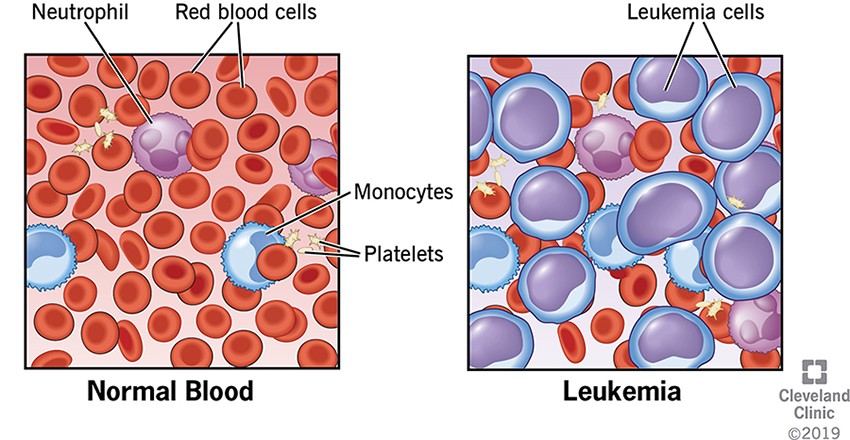ABOUT Leukemia
Leukemia
Leukemia is a type of cancer that starts in the blood
cells. It can develop slowly and cause no symptoms, but it can also develop
quickly and cause symptoms such as fevers, swollen lymph nodes, or unexplained
bruises. You should see a doctor right away if you have any of these symptoms.
The goal of treatment for leukemia is to kill abnormal white blood cells and
bring back healthy ones. Treatment can include chemotherapy and radiation
therapy, which means there may be some side effects like nausea and hair loss.
What Are Its Symptoms?
Leukemia can cause several symptoms, which include:
Fever
A person who has leukemia might have a fever that is
higher than their normal temperature. A fever can be a sign of many different
types of infections, but it's also one of the earliest signs of leukemia. A
person with leukemia will usually have a temperature above 100 degrees
Fahrenheit (37.8 degrees Celsius). In some cases, the temperature could be as
high as 104 to 107 degrees Fahrenheit (40 to 42 degrees Celsius). The presence
or absence of other symptoms will help your doctor figure out if the elevated
temperature is cause for concern.
Swollen Lymph Nodes
A person with leukemia may have swollen lymph nodes in
their neck, armpit, or groin.
Shortness of Breath
Leukemia can cause a person to struggle for breath and
have a great deal of trouble breathing. You may notice this when you're smoking
or exercising. In rare cases you might not notice the shortness of breath
because it's so small and mild, but if you do you should call your doctor right
away to have it checked out.
Weight Loss
Any time a person is experiencing symptoms of cancer,
they may want to lose weight as a way to improve their health and fitness
levels. The problem with this is that while a person may appear thinner, they
may not be losing fat. They could be losing muscle mass and bone density. This
will make them appear smaller while making them weaker and more vulnerable to
additional health problems.
Diarrhea
Diarrhea can occur in a person with leukemia because
their body is having trouble absorbing nutrients from food.
Anemia
Anemia occurs when a person's bone marrow isn't
producing enough healthy blood cells to keep up with the body's demand for
oxygen-rich red blood cells.
Prevention of Leukemia
There are no preventative measures you can take to
reduce your risk of developing leukemia. As with most cancers, the cause is
unknown.
Diagnosis of Leukemia
When a person visits a physician because they think
they have leukemia, the first step will be to look for any infections. If you
have an infection, your doctor will clear it up and reassess if you still need
treatment for leukemia.
If there's no sign of infection, then your doctor will
do a physical exam and possibly order some tests:
Complete blood count (CBC). A complete blood count
measures how many red blood cells, white blood cells, and platelets you have in
each cubic millimeter of blood. There are other types of complete blood counts,
but they all measure these three components. This test can help doctors check
for certain infections, anemia, and leukemia.
A complete blood count measures how many red blood
cells, white blood cells, and platelets you have in each cubic millimeter of
blood. There are other types of complete blood counts, but they all measure
these three components.
This test can help doctors check for certain
infections, anemia, and leukemia. Bone marrow biopsy. A bone marrow biopsy is
used to diagnose leukemia because the bone marrow is where the body makes new
healthy cells.
Frequently Asked Questions on Leukemia
What Is Bone Marrow Biopsy?
Bone marrow biopsy is done by inserting a hollow needle
into the hips through which they suck out some bone marrow from the center of
the pelvic bone. They may also take a sample from your abdominal lining if you
have a condition called hairy cell leukemia that causes enlargement of the
spleen and liver, or from your ribs or sternum if you have acute myelogenous
leukemia.
What Is Radiation Therapy?
Radiation therapy treats cancer by killing cancer cells
or preventing them from growing. Radiation therapy is also called radiotherapy,
x-ray therapy, or irradiation. The type of radiation used for leukemia is
called "internal radiation." Internal radiation means the radiation
is injected into the body near the part of the body where it is needed. Once
internal radiation reaches a cancer cell (target cell) it destroys it and any
nearby healthy cells. Radiation is usually used after chemotherapy to kill any
remaining cancer cells and prevent recurrence (return).

